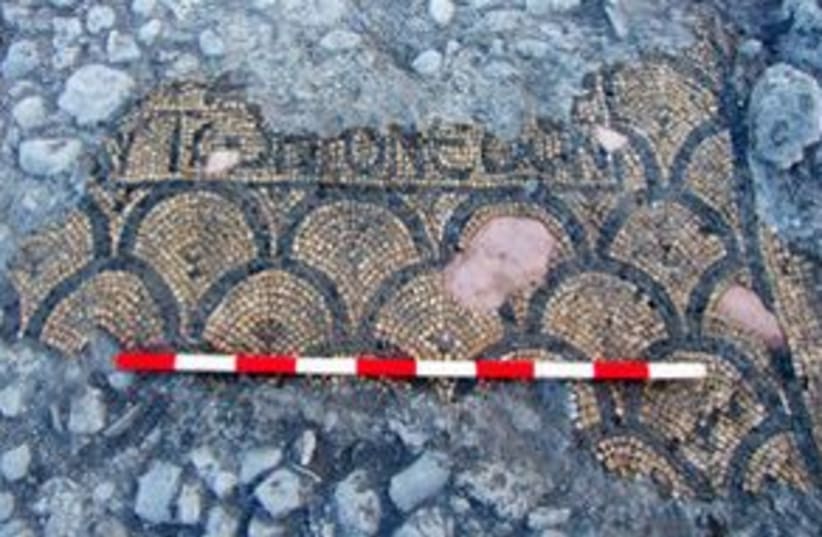RELATED:King Herod's royal theater box uncovered at HerodiumArcheological digs in North unearth rare signet ringDirectors of the Israel Antiquities Authority excavation, Dr. Walid Atrash and Ya’aqov Harel issued a statement Monday saying “the synagogue that is currently being revealed played an important part in the lives of the farmers who inhabited the surrounding region, and it served as a center of the spiritual, religious and social life there.”The statement added that the synagogue, which is believed to have stood from the fifth century CE until the eve of the Muslim conquest in 634 CE is indicative of how in the Byzantine period (fourth century CE), "Beit Shean became an important Samaritan center under the leadership of Baba Rabbah, (an ancient Samaritan leader and reformer) at which time the Samaritans were granted national sovereignty and were free to decide their own destiny. This was the case until the end of the reign of Emperor Justinian, when the Samaritans revolted against the government. The rebellion was put down and the Samaritans ceased to exist as a nation."The building includes a 40 square meter rectangular hall which faces Mount Gerizim, the mountaintop outside Nablus that is the holiest site in the Samaritan religion and the site of the present-day Samaritan village of Kiryat Luza. Across the floor of the hall an intricate mosaic was laid which included geometric patterns and an inscription reading "This is the temple."The synagogue joins “Beit Leontis” and “Tel Iztabba,” two other Samaritan houses of worship discovered in Beit Shean.The Samaritans are Israel’s smallest minority and one of the world’s oldest and smallest religious sects, numbering barely over 700 with a history that dates to before the Babylonian exile. Around half of the community lives in the enclave of Neve Pinchas in Holon, while the rest live on Mount Gerizim, some 800 meters above the outskirts of Nablus.The Samaritan religion is separate from Judaism but has many parallels, though it does not accept traditions or religious interpretations from the Jewish Diaspora.
1,500-year-old Samaritan synagogue found by Beit Shean
Recent discovery reveals historical details of ancient sect during national renaissance in the Byzantine period.

RELATED:King Herod's royal theater box uncovered at HerodiumArcheological digs in North unearth rare signet ringDirectors of the Israel Antiquities Authority excavation, Dr. Walid Atrash and Ya’aqov Harel issued a statement Monday saying “the synagogue that is currently being revealed played an important part in the lives of the farmers who inhabited the surrounding region, and it served as a center of the spiritual, religious and social life there.”The statement added that the synagogue, which is believed to have stood from the fifth century CE until the eve of the Muslim conquest in 634 CE is indicative of how in the Byzantine period (fourth century CE), "Beit Shean became an important Samaritan center under the leadership of Baba Rabbah, (an ancient Samaritan leader and reformer) at which time the Samaritans were granted national sovereignty and were free to decide their own destiny. This was the case until the end of the reign of Emperor Justinian, when the Samaritans revolted against the government. The rebellion was put down and the Samaritans ceased to exist as a nation."The building includes a 40 square meter rectangular hall which faces Mount Gerizim, the mountaintop outside Nablus that is the holiest site in the Samaritan religion and the site of the present-day Samaritan village of Kiryat Luza. Across the floor of the hall an intricate mosaic was laid which included geometric patterns and an inscription reading "This is the temple."The synagogue joins “Beit Leontis” and “Tel Iztabba,” two other Samaritan houses of worship discovered in Beit Shean.The Samaritans are Israel’s smallest minority and one of the world’s oldest and smallest religious sects, numbering barely over 700 with a history that dates to before the Babylonian exile. Around half of the community lives in the enclave of Neve Pinchas in Holon, while the rest live on Mount Gerizim, some 800 meters above the outskirts of Nablus.The Samaritan religion is separate from Judaism but has many parallels, though it does not accept traditions or religious interpretations from the Jewish Diaspora.